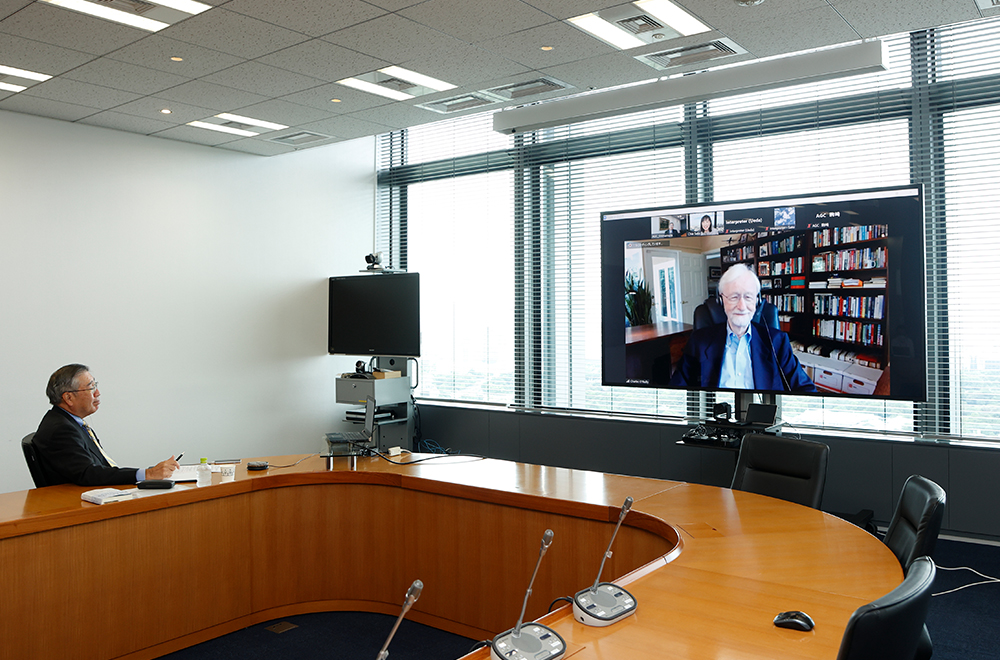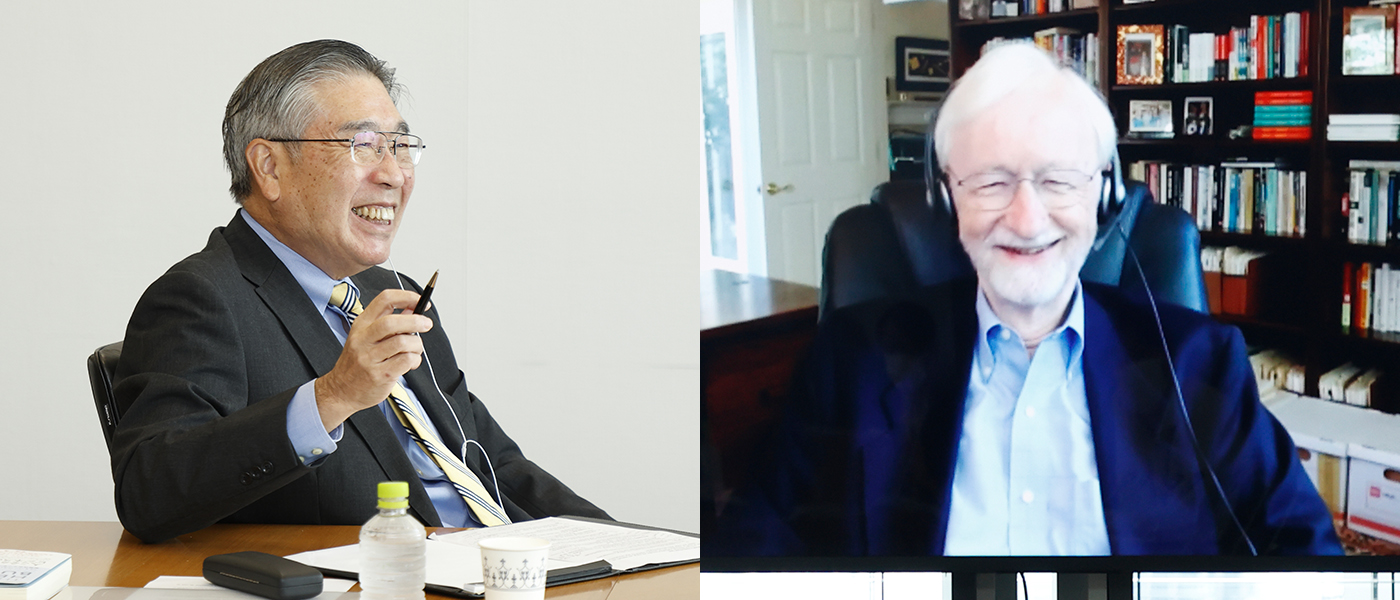
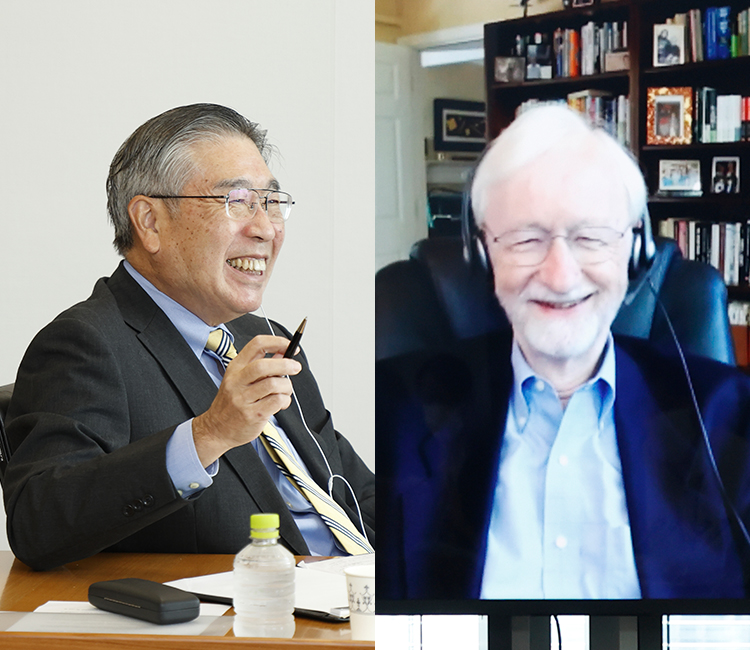
AGC's Pursuit of Ambidextrous Strategy: A Discussion with Charles A. O' Reilly
- #Management Strategies
On August 5, 2022, Chairman Shimamura held an online dialogue with Charles A. O’Reilly, Professor of Management at the Stanford Graduate School of Business (Stanford GSB).
Profile
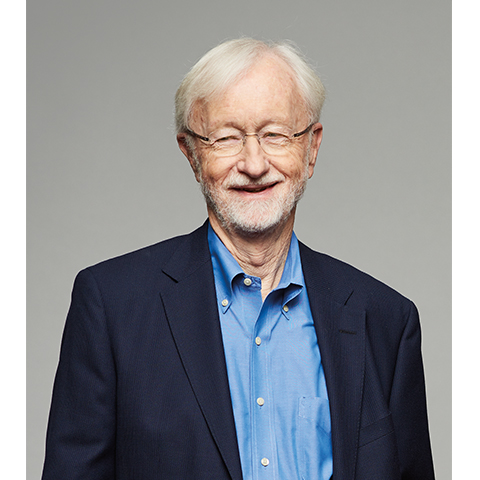
Charles A. O'Reilly ©Drew Kelly
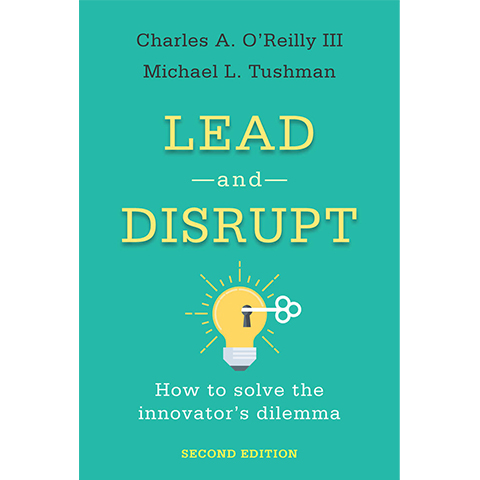
Charles A. O'Reilly ©Drew Kelly
Charles A. O’Reilly is a Professor of Management (Organizational Behavior) at the Stanford Graduate School of Business (Stanford GSB), where he teaches “Leadership Perspectives” and “Beyond Disruption: Entrepreneurial Leadership Within Existing Organizations.” His research spans studies of leadership, organizational demography and diversity, culture, executive compensation, and organizational innovation and change. He is well-known as one of the world’s leading authorities on Ambidexterity. His latest publications include “Lead and Disrupt: How to Solve the Innovator’s Dilemma The Second Edition” (Co-Author, Stanford Business Books, 2021), and “The Corporate Explorer”(Co-Author, Wiley, 2022). “Lead and Disrupt” has long been a bestseller in Japan.
Moderator: Chie Sato
Chie Sato is an Author/Consultant/Media Personality with several best-selling publications in Japan. Sato has written numerous articles for newspapers, magazines, and online media, and has given lectures related to business schools, leadership, and management. Before becoming independent in 2012, Sato served as an executive producer at Disney Channel, a management consultant at The Boston Consulting Group, and a TV producer/director at NHK, Japan Broadcasting Corporation. Sato has published 17 books since 1993 ( https://www.satochie.com/books), and her books have been translated into Korean, Chinese, and Mongolian.

Chie Sato
Sato currently serves as an Independent Director at a leading IT company in Japan. Sato holds an MBA from Columbia Business School and a Bachelor of Liberal Arts from The University of Tokyo.
--AGC has promoted its ambidextrous strategy since 2015. To begin with, could you tell us why you think it important for any large corporations to ‛explore and exploit’ in the present world filled with uncertainty and ambiguity?
Charles O’Reilly I think two big forces are affecting businesses in large corporations all over the world.
One is the acceleration of the pace of technological change. The rate at which new technologies are emerging and being used is accelerating. A lot of technologies have emerged in such areas as Artificial Intelligence and machine learning, which has completely changed business models.
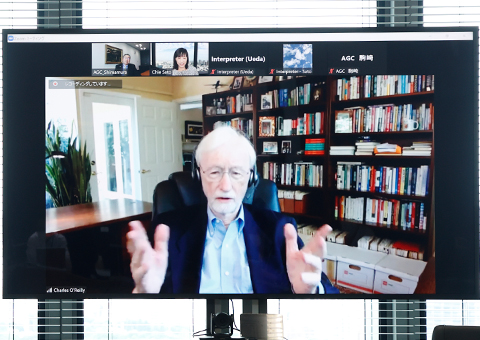
Charles O’Reilly
The other is the acceleration of the pace of change. With the emergence of new technologies, government regulations change and consumer preferences change. Larger, older companies are especially affected by all of these forces.
And what we’re seeing is that many great companies around the world are in trouble. Their core businesses are being disrupted. I think the only way a big successful company can survive in the face of change is to not only exploit their existing business, but to also explore new opportunities and move their assets and capabilities into growth areas. This is what ambidexterity is about.
Takuya Shimamura As we set in Vision 2030 and AGC plus, Ambidexterity has been a critical strategy for AGC since I became a CEO in 2015.
We are a company with a history of more than 100 years. We have produced flat glass for more than 100 years. But there will not be dramatic growth in the core business anymore. If we want to survive and grow, we have to reconstruct our style for the future. We believe Ambidexterity is the only way for us to survive and grow.
--AGC was featured in the Stanford GSB case “AGC Inc. in 2019: Your Dreams, Our Challenge.” Could you tell us the purpose of the case and the response from students and employees?
Charles O’Reilly I was looking for the companies that were pursuing Ambidexterity for my case studies, and I thought AGC would be a wonderful example, firstly because AGC was an old and large corporation that was trying hard to be ambidextrous, secondly because AGC was a company outside the US.
I have already taught this case in my courses at Stanford GSB, and it has been very well-received because it challenges the stereotypical view of Japanese corporations. Many American students have a perception that Japanese companies are old and have difficulty with change.
AGC is an old Japanese company with more than 100 years of history that is exploring and exploiting simultaneously. AGC is dramatically changing organizations and businesses and leveraging its assets into new markets. Chairman Shimamura and AGC’s approach is applicable not just in Japan but around the world. Our students find it very instructive to see how a leader might change a large organization.
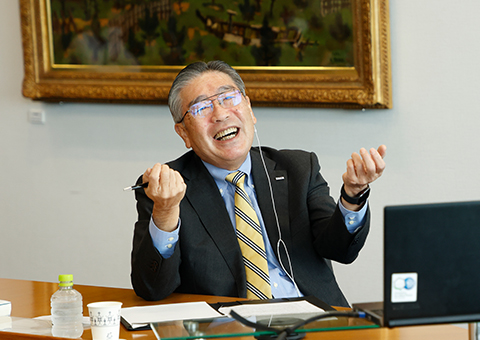
Mr. Takuya Shimamura,Director Chairman,AGC.
Takuya Shimamura AGC Group members feel honored to find that a world-renowned scholar at Stanford GSB featured their challenge. The third-party view is very encouraging for us.
Frankly speaking, I was surprised to find that AGC would be featured in the Stanford GSB case. It was totally unexpected. AGC was an old Japanese company. I did not expect MBA students in the US would be particularly interested in AGC because it would be hard for them to relate to B2B material businesses outside of the US.
Moreover, I didn’t know there was a management theory called Ambidexterity. I participated in the AMP (Advanced Management Program) course at Harvard Business School in 2007, and I learned innovation from Professor Michael Tushman, co-author of Lead and Disrupt. But I did not realize what I was trying to do as a CEO was called Ambidextrous Leadership.
Charles O’Reilly As academics and researchers, we watch and learn from leaders like Chairman Shimamura. It is terrific that Chairman Shimamura was engaging in ambidexterity before he even knew the theory. So, we were just privileged to be able to document what he and AGC’s employees had done.
--AGC is also featured in the second edition of Lead and Disrupt: How to Solve the Innovator’s Dilemma. The book highlights the importance of the corporate culture in implementing Ambidexterity. From a cultural standpoint, how do you view AGC’s ambidexterity?
Charles O’Reilly First of all, we wrote about corporate culture in the second book because culture is such an important part of any transformation. Corporate culture can be a hidden barrier or a silent barrier to change, and so I thought it was very important to be explicit about the role of culture.
I think part of AGC’s success is that top management not only used the ‛explore and exploit’ aspect of ambidexterity, but also simultaneously got people involved and changed the corporate culture and gave them a larger purpose. Chairman Shimamura is a great example of a leader who is simultaneously managing the culture and structure of the company.
Takuya Shimamura I thought the book Lead and Disrupt: How to Solve the Innovator’s Dilemma was very impressive. Most books teach us how to brush up on management skills, but there are few on how to revitalize a big company, really. Every leader at a large corporation struggles with growing the business. In this world filled with volatilities and uncertainties, a company’s legacy alone is no longer effective.
I think Professor O’Reilly’s book is especially helpful for leaders and managers at a large corporation with a long history like us. And it is also helpful for young employees. With the book, they can better understand what top management is trying to do.
Charles O’Reilly From a cultural standpoint, I was impressed with leaders’ honesty and openness. I did lots of interviews for my case-writing. When I interviewed them, they – from top management to middle-level managers –were all very candid with us. They told me what did not work. It’s courageous of leaders to be completely open about both what they are doing well and what they are not doing well.
Takuya Shimamura All of us thought there was nothing to hide. We just wanted the case to be a great learning tool for Stanford GSB students and future leaders. Also, this was a learning process for us. Without speaking candidly about our failures, how could we get helpful advice from Professor O’Reilly?
Charles O’Reilly I was also impressed with the entrepreneurial spirit of young employees. I met some of the leaders who were running these new businesses. They were quite amazing. They reminded me of some of the entrepreneurs that I talked to in Silicon Valley. So, I felt both the Monozukuri culture and entrepreneurial culture co-existed in the company.
I have often seen young people in large organizations become demotivated because of inflexible and hierarchical structures and processes. They sometimes let down those young employees who want to change or make things happen. On the contrary, the employees I met at AGC were so motivated.
So, the key to empowering employees is to help organizations design themselves in ways that these young people can actually get involved and pursue some of their ideas. I think this is one of the things that AGC’s management team has been trying really hard, and its reform really worked.
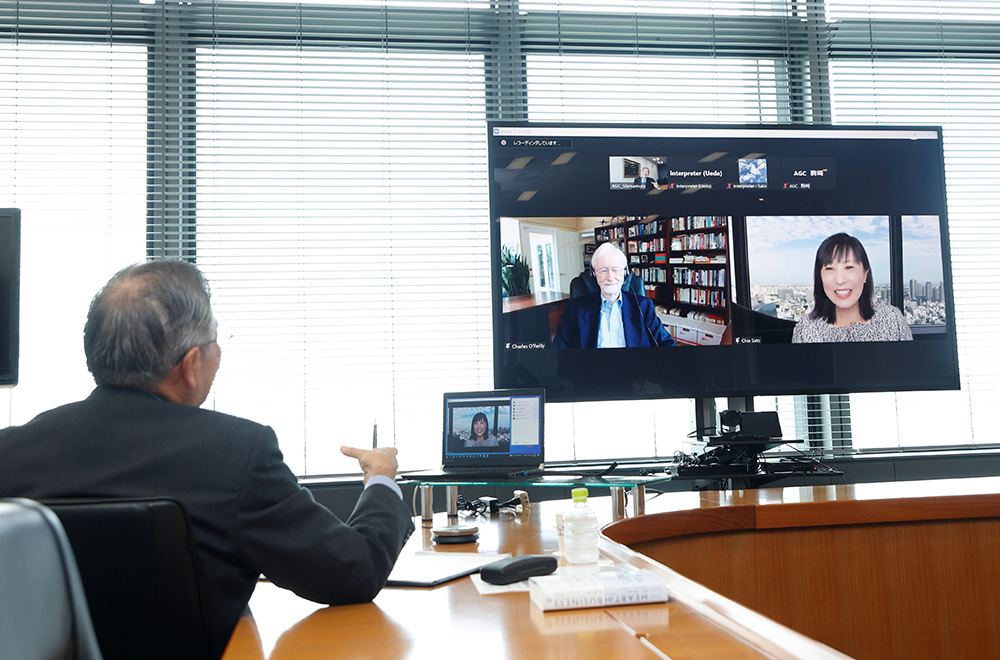
--At AGC, a lot of Top Management Talk Sessions have been held since 2015. Could you tell us the aim and the effect of the meetings?
Takuya Shimamura When I became CEO in 2015, the company environment was very gloomy. A year before I became the CEO, our profit level was a quarter of what it had been in 2010. I wanted to really brighten up the organization. While it was crucial for me to restructure portfolio, it was equally important to manage culture, because I believed people were one of the most important pillars of AGC’s growth.
As Professor O’Reilly said, young people had great ideas but they did not have opportunities to speak up because middle managers did not want them to fail.
I once had a session with middle managers and I asked, “Why don’t you give more challenging experiences to the younger people?”. And then one manager raised his hand and said, “I do understand what you say. But as a manager, I don’t want to see the young people fail.” So, I decided to talk directly with all employees at any level.
In my first three years, I probably visited approximately 50 sites per year. On each site, I had several sessions. So, I would say I had almost 150 face-to-face meetings per year for three years.
Initially, young people were reserved. But after three years, they become more open-minded and more straightforward. We did surveys in 2019, and we saw significant improvements in such sections as ‘Respect & Recognition’ and ‘Development Opportunities’.
Charles O’Reilly I think having 150 face-to-face meetings per year for three years is admirable. Transformation efforts require senior managers to be constantly interacting with employees. Transformations often fail because the senior managers don’t put in enough effort to communicate with employees. They stay in the office and don’t go talk to employees. I think what Chairman Shimamura did was consistent with what other successful change leaders did.
Takuya Shimamura At the meeting, I highlighted our founder’s spirit: Never take the easy way out, but confront difficulties. Trust is the best way to inspire people. Strive to develop technologies that will change the world. A sense of mission leads us to advance.
I dared to do so because it was the concept that every AGC Group members could resonate with. It explicitly stipulated why the company was built. It showed what employees should aim for.
In this changing environment, there are factors that you can control and those that you cannot. It was obvious that our employees looked at the same goal. So, I thought, “Why don’t we go back to our founding spirits so that everyone can be re-convinced of the need to rebuild?”
Charles O’Reilly I agree with Chairman Shimamura. Let me tell you how you can fail at a culture change effort. You will fail if you come in and say, “Everything we did in the past was bad and now we have to do things differently.” That dishonors the past and the people who have worked for many years. They have worked hard. They have tried to do their best. To belittle their efforts is the wrong way to do it.
Going back to the founding spirit is a very wise way to do it. With the spirit, you can say, “We are going to take those things that are important and we are going to continue that. And in a different world, we are going to add some new things.” It is to preserve the things that have made us successful in the past but also add the things that we need to be successful in the future.
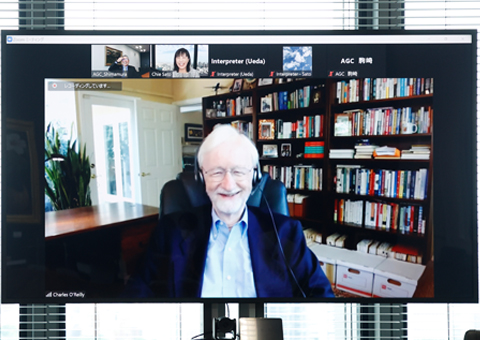
--What would you expect for the future of AGC?
Charles O’Reilly First of all, I would love to write another case on AGC because I would like to follow up on the company’s story. When we write a case, we take a snapshot of something that’s going on at a particular time. But who knows what’s going to happen in the future?
So, if I were to write a second case, I would like to do a couple of things. I would like to know what has worked and what has not worked with new businesses – mobility, electronics, and life sciences. I would like to talk to some of the younger employees. Do they feel engaged? Do they feel enthusiastic? Now I would like the second case to be a success story for AGC.
Takuya Shimamura It’s an honor.
Charles O’Reilly But there is no guarantee that it would be a success. If the current top management continues the journey, then I think it will be a success.
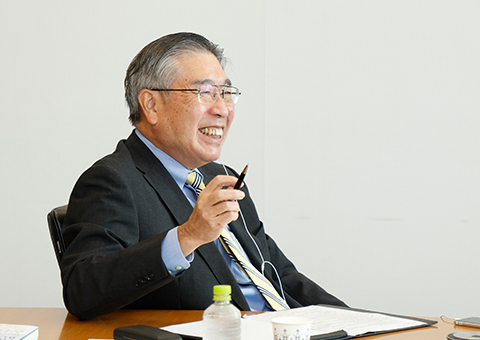
Takuya Shimamura My role, as a leader of phase one, was to raise the bottom line of the entire company and to work on the fundamental reform: restructuring the portfolio, designating strategic businesses that can bring about growth in the future, and closing down some businesses.
It was also my responsibility to redefine the role of each sector and business and tell all of the employees: “This is your new goal”. Specifically, to the employees at core businesses, I emphasized “Generating cash is your goal, not generating profits.”
And I would say Yoshinori Hirai, current CEO, is working hard on phase two of the Ambidextrous strategy of AGC.
His role is to incubate and scale our strategic businesses for the further growth of the company. He clearly understands his role and reinforces our goal over and over for all employees.
Charles O’Reilly I hope that when we write the next case, the company will be even more successful because not only top management but also the employees have made it successful.
I think exploiting the core businesses and exploring and scaling the new businesses are critical to the future of the company.
I hope that the employees both in core businesses and new businesses understand the ambidexterity and remain engaged in AGC and feel proud of the company.
